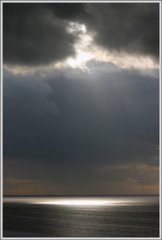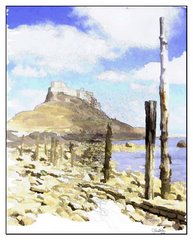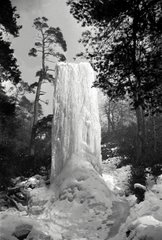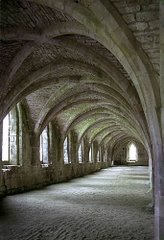CHESTERFIELD CANAL. from "Priestley's Navigable Rivers and Canals"
11 George III. Cap. 7.5, Royal Assent 28th March, 1771.
THIS canal commences in the tideway of the Trent, at Stockwith, in Nottinghamshire, near to the place where the navigable River Idle falls into it, about four miles below Gainsborough. Its course is nearly west for six miles, passing round to the north of Gringley Beacon, whence it pursues a southerly course, to East Retford; thence, westward, by Worksop, to Shire Oaks, where it enters the county of York; when passing south of the village of Wales, and entering Derbyshire, it proceeds, in a southerly course, along the east bank of the River Rother, through a country abounding in coal, to Chesterfield, where it terminates. Its length is forty-six miles. From the Trent to Worksop it is twenty-four miles, with a rise of 250 feet; from thence, to the summit, at the tunnel near Harthill, nine miles, with a rise of 85 feet, being a total rise of 335 feet From the summit to Chesterfield, the distance is thirteen miles, with a fall of 45 feet. The number of locks is sixty-five. Between Wales and Harthill there is a tunnel two thousand eight hundred and fifty yards in length; it is in width 9¼ feet, and 12 feet high. Near Gringley Beacon is another tunnel one hundred and fifty-three yards in length. Between the long tunnel and Chesterfield, many individuals have laid down private railways, for the purpose of transporting the production of the mines and iron-works in that district.
This navigation was projected by Mr. Brindley, in 1769, but before any application was made to parliament for authority to carry it into execution, Mr. Grundy was directed to view the intended line of canal, upon which he reported in August, 1770. His proposal was to carry the line of canal from Stockwith, in nearly a straight course, to Bawtry, and from thence, by Scrooby, Blyth, and Carlton, and to join Brindley's line at the Shire Oaks.
Mr. Brindley's estimate was £94,908, 17s. and the length, according to the original plan made by Mr. Varley, is forty-four miles, six furlongs and eight chains and a half, and Grundy's estimate, by his proposed alteration, is £71,479, 6s. 9½d. being less by £23,429, 10s. 2½d. and shorter by nearly five miles and a half; yet, notwithstanding the apparent advantages of Grundy's line, such confidence had the proposed company in Brindley's designs, that they applied to parliament and obtained an act to enable them to carry his scheme into execution; it is entitled, 'An Act for making a navigable Cut or Canal from Chesterfield, in the county of Derby, through or near Worksop and Retford, to join the River Trent, at or near Stockwith, in the county of Nottingham.' The proprietors, at the time the act was obtained, consisted of one hundred and seventy-four persons, amongst whom were the Most Noble the Dukes of Devonshire and Newcastle, Lord Scarsdale, the Dean of York, and Sir Cecil Wray, Bart. who were incorporated by the name of" The Company of Proprietors of the Canal Navigation from Chesterfield to the River Trent," and empowered to raise among themselves the sum of £100,000, in one thousand shares of £100 each, for the purpose of carrying the same into execution, but the canal was not to be begun until the whole sum was raised; and in case the above sum was insufficient, they might raise among themselves, or by the admission of new subscribers, or by mortgage of the rates and duties, the additional sum of £50,000. The work to be managed by a committee, under the control of the general assembly. The act, which is very long, contains many clauses for the protection of private property; particularly such as belong to the Dukes of Norfolk and Leeds, and Lord Byron. Immediately on the passing of the act, the works were commenced, under the direction of Mr. Brindley, and so continued until his death, in September, 1772, when they were conducted and finished by Mr. Henshall, his brother-in-law, in 1776. From the Trent to Retford, the canal is constructed for vessels of fifty to sixty tons burthen; the remaining portion is for such as carry about twenty tons only.
11 George III. Cap. 7.5, Royal Assent 28th March, 1771.
THIS canal commences in the tideway of the Trent, at Stockwith, in Nottinghamshire, near to the place where the navigable River Idle falls into it, about four miles below Gainsborough. Its course is nearly west for six miles, passing round to the north of Gringley Beacon, whence it pursues a southerly course, to East Retford; thence, westward, by Worksop, to Shire Oaks, where it enters the county of York; when passing south of the village of Wales, and entering Derbyshire, it proceeds, in a southerly course, along the east bank of the River Rother, through a country abounding in coal, to Chesterfield, where it terminates. Its length is forty-six miles. From the Trent to Worksop it is twenty-four miles, with a rise of 250 feet; from thence, to the summit, at the tunnel near Harthill, nine miles, with a rise of 85 feet, being a total rise of 335 feet From the summit to Chesterfield, the distance is thirteen miles, with a fall of 45 feet. The number of locks is sixty-five. Between Wales and Harthill there is a tunnel two thousand eight hundred and fifty yards in length; it is in width 9¼ feet, and 12 feet high. Near Gringley Beacon is another tunnel one hundred and fifty-three yards in length. Between the long tunnel and Chesterfield, many individuals have laid down private railways, for the purpose of transporting the production of the mines and iron-works in that district.
This navigation was projected by Mr. Brindley, in 1769, but before any application was made to parliament for authority to carry it into execution, Mr. Grundy was directed to view the intended line of canal, upon which he reported in August, 1770. His proposal was to carry the line of canal from Stockwith, in nearly a straight course, to Bawtry, and from thence, by Scrooby, Blyth, and Carlton, and to join Brindley's line at the Shire Oaks.
Mr. Brindley's estimate was £94,908, 17s. and the length, according to the original plan made by Mr. Varley, is forty-four miles, six furlongs and eight chains and a half, and Grundy's estimate, by his proposed alteration, is £71,479, 6s. 9½d. being less by £23,429, 10s. 2½d. and shorter by nearly five miles and a half; yet, notwithstanding the apparent advantages of Grundy's line, such confidence had the proposed company in Brindley's designs, that they applied to parliament and obtained an act to enable them to carry his scheme into execution; it is entitled, 'An Act for making a navigable Cut or Canal from Chesterfield, in the county of Derby, through or near Worksop and Retford, to join the River Trent, at or near Stockwith, in the county of Nottingham.' The proprietors, at the time the act was obtained, consisted of one hundred and seventy-four persons, amongst whom were the Most Noble the Dukes of Devonshire and Newcastle, Lord Scarsdale, the Dean of York, and Sir Cecil Wray, Bart. who were incorporated by the name of" The Company of Proprietors of the Canal Navigation from Chesterfield to the River Trent," and empowered to raise among themselves the sum of £100,000, in one thousand shares of £100 each, for the purpose of carrying the same into execution, but the canal was not to be begun until the whole sum was raised; and in case the above sum was insufficient, they might raise among themselves, or by the admission of new subscribers, or by mortgage of the rates and duties, the additional sum of £50,000. The work to be managed by a committee, under the control of the general assembly. The act, which is very long, contains many clauses for the protection of private property; particularly such as belong to the Dukes of Norfolk and Leeds, and Lord Byron. Immediately on the passing of the act, the works were commenced, under the direction of Mr. Brindley, and so continued until his death, in September, 1772, when they were conducted and finished by Mr. Henshall, his brother-in-law, in 1776. From the Trent to Retford, the canal is constructed for vessels of fifty to sixty tons burthen; the remaining portion is for such as carry about twenty tons only.
RATES OF TONNAGE AND WHARFAGE.
Lime 1d per Ton, per Mile.
Coal, Lead, Timber, Stone, and all other Goods, Wares and Merchandize 1½d ditto ditto.
Soap, Ashes, Salt, Salt-scrow, Foul Salt, and Grey Salt, Soot, Bone-dust, Pigeons' Dung, Rape or Cole Seed Dust, to be used for the manuring of Lands of any Persons, whose Lands shall be Cut through by this Canal, such Lands being in any Township through which it passes, and Rags or Tanners' Bark ½d ditto ditto.
EXEMPTION FROM TOLL.
Hay, and Corn in the Straw, not sold, but to be laid up in the Outhouses of the Owner; Small Rubbish or Waste Stones, Gravel and Sand for the repair of Roads, (not being Turnpike) in any Township through which the Canal passes, and which shall not be carried more than Five Miles.
Dung, Soil, Marl, Ashes of Coal and Turf, for the Improvement of Lands lying in any Township through which the Canal will pass, and belonging to Persons whose Lands may be taken for the Canal, provided these excepted Articles do not pass a Lock, except when the Water is running over the Gauge or Niche of the Lock.
If any Iron, Iron-stone, Coals, Lime for the Improvement of Lands, or other Goods whatsoever, remain on the Wharfs longer than Twenty-four Hours, then such additional Rate to be paid as may be agreed upon.
Fifty Feet of Round, or Forty Feet of Square Oak, Ash, or Elm Timber, or Fifty Feet of Fir, or Deal, Balk, Poplar, and other Timber Wood, shall be deemed One Ton.
A Ton of Coal or Limestone to be Twenty-two Hundred Weight of One Hundred and Twelve Pounds each.
Vessels under Twenty Tons not to pass Locks without leave unless they pay for that Weight.
RATE,
To be received by any Lord of the Manor or Owner of Land who may erect Wharfs.
For every description of Goods or Merchandize for a period less than Six Days 3 per Ton.
Up to the year 1789, the whole of the works had cost about £152,400, and the following is a statemeat of the income and expenditure of that year:-
INCOME AND EXPENDITURE.
£.s.d.
The Gross Income in that Year, was £8,320. 9s. 6d
Expenditure, which included Interest to the Amount of £2,670, exclusive of Arrears £5,540 9s. 3d.
Nett Income £2,780 0s. 3d.
Upon which a Dividend of One per Cent. only was paid, amounting to £990.
A tolerable idea of the traffic upon this canal, at that period, (forty years ago) may be formed, from the following return of tonnage made by the proprietors, in 1789.
RETURN OF TONNAGE.
Tons.
Coal 42,379½
Lead 3,862¼
Lime 3,955¼
Corn 4,366¼
Stone 7,569¾
Iron 1,554½
Timber 3,444¼
Sundries 7,180¼
tot. 74,312 Tons
Upon which the Duties and wharfage amounted to £8,303 9s. 6d.
Sixteen years after this period the proprietors divided six per cent, and the undertaking has been gradually improving.
The chief objects of this canal are the export of coal, lime, and lead from Derbyshire, and, of the produce of the iron furnaces in the neighbourhood of Chesterfield; and corn, deals, timber, groceries, &c. on the other hand, are conveyed into the county of Derby.
Lead 3,862¼
Lime 3,955¼
Corn 4,366¼
Stone 7,569¾
Iron 1,554½
Timber 3,444¼
Sundries 7,180¼
tot. 74,312 Tons
Upon which the Duties and wharfage amounted to £8,303 9s. 6d.
Sixteen years after this period the proprietors divided six per cent, and the undertaking has been gradually improving.
The chief objects of this canal are the export of coal, lime, and lead from Derbyshire, and, of the produce of the iron furnaces in the neighbourhood of Chesterfield; and corn, deals, timber, groceries, &c. on the other hand, are conveyed into the county of Derby.












No comments:
Post a Comment